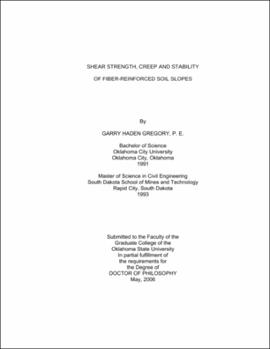| dc.contributor.advisor | Snethen, Donald R. | |
| dc.contributor.author | Gregory, Garry Haden | |
| dc.date.accessioned | 2013-12-10T18:05:33Z | |
| dc.date.available | 2013-12-10T18:05:33Z | |
| dc.date.issued | 2006-05 | |
| dc.identifier.uri | https://hdl.handle.net/11244/7836 | |
| dc.description.abstract | Fiber-reinforced soil (FRS) has been used successfully on more than 50 embankment slopes in the United States in recent years. The geosynthetic fiber reinforcement has consisted predominantly of 25 to 50 mm long polypropylene fibers. These fibers, when mixed into the soil, significantly increase the apparent shear strength of the entire soil mass. This study includes an extensive laboratory testing program to characterize shear strength of clay and silty sand soils reinforced with synthetic fibers as compared to non-reinforced soil. A series of creep tests were also performed to obtain an initial indication of the resistance of FRS to creep failure. The creep test results indicate an increased resistance to creep of FRS compared to non-reinforced soil. A theoretical conceptual model is presented which can be used to mathematically calculate the shear strength of the soil when reinforced with fibers, referred to as the FRS shear strength. The model includes a unique effective normal stress formulation based upon 3-dimensional random orientation of the fibers under geostatic stress conditions in a half-space continuum (soil mass). The model utilizes an "effective aspect ratio," a_re, which is different than the conventional aspect ratio based upon the actual fiber length-equivalent diameter ratio. The input to the model includes the fiber volume ratio (ratio of fiber volume to total volume of a unit mass of FRS), unique effective stress variable, effective aspect ratio, frictional and adhesion interaction coefficients, and the non-reinforced soil shear-strength parameters phi and c. The model was calibrated and validated based upon comparison of calculated results and actual shear strength test results performed during this study, and also compared to other available test results. Case histories of two major FRS projects are presented in the study. | |
| dc.format | application/pdf | |
| dc.language | en_US | |
| dc.rights | Copyright is held by the author who has granted the Oklahoma State University Library the non-exclusive right to share this material in its institutional repository. Contact Digital Library Services at lib-dls@okstate.edu or 405-744-9161 for the permission policy on the use, reproduction or distribution of this material. | |
| dc.title | Shear strength, creep and stability of fiber-reinforced soil slopes | |
| dc.contributor.committeeMember | Oberlender, Garold D. | |
| dc.contributor.committeeMember | Cross, Stephen A. | |
| dc.contributor.committeeMember | Halihan, Todd | |
| osu.filename | Gregory_okstate_0664D_1744.pdf | |
| osu.accesstype | Open Access | |
| dc.type.genre | Dissertation | |
| dc.type.material | Text | |
| thesis.degree.discipline | Civil Engineering | |
| thesis.degree.grantor | Oklahoma State University | |
